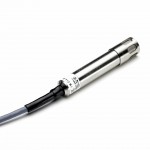Beyond IoT: pervasive sensing
Published: 03 March, 2016
In manufacturing facilities, unplanned outages force continuously operating processes to go through shutdown and start-up procedures. It's under these conditions that serious incidents are most likely to occur. Jonathan Wilkins, marketing director of obsolete components supplier European Automation, discusses pervasive sensing techniques and technologies, and the impact they're having on manufacturing.
Ideally, manufacturers should to be able to anticipate equipment failures to prevent these outages. Previously, monitoring a wide range of pumps, drives, motors, steam traps, relief valves, and other equipment was implausible because of high operating costs. However, the increasing availability of inexpensive, wireless sensors now let's facilities measure safety, regulatory compliance, equipment reliability and energy efficiency without breaking the bank.
To ensure operational excellence, industrial processes need better predictive capabilities that can trigger responses quickly. It's predicted there will be fewer process experts available in the future, so it's vital to consider how to get the best out of the expertise on hand. This means ensuring experts aren't spending most of their time travelling to a site, but instead are able to apply their knowledge remotely for plant diagnostics.
Traditionally, the cost of adding a wired sensor to gather data was very high. This has limited many manufacturers to only collecting data from critical applications. Today’s sensor technology, including wireless and non-invasive sensors, has made installation cost-effective and maintenance straight-forward. The embedded technology inside today’s sensors now allows them to provide direct actionable information.
At the 2013 Emerson Exchange, the concept of pervasive sensing was introduced to industry to explain how smart sensors gather actionable information to improve operations and maintenance.
Using the example of tire motoring, Emerson illustrated how technology is now being used to accomplish tasks that were previously carried out manually. Today, wireless sensors in each tire constantly monitor the pressure and provide automated warnings and specific maintenance instructions to the driver on the car dashboard.
A pervasive sensor is a robust sensor with no requirement for maintenance or calibration once installed. It's typically a clamp-on sensor or externally mounted. Pervasive sensing devices include vibration sensing of rotating equipment, ultrasonic leak detectors, wireless steam trap monitors, corrosion and erosion detection technology, as well as wireless bolt-on surface temperature probes. Using multiple sensors to gather information makes it possible to detect and respond to hazards before they become a danger to people and equipment. The technology can also predict failures, reduce downtime, avoid environmental issues and identify potential security threats.
In manufacturing, pervasive sensing helps in both process-critical and business-critical applications. Process-critical refers to process control and process safety applications. This data requires immediate response to prevent off-spec product or even plant shutdown. Most of the equipment involved is already automated, since sensors generally connect to an existing process control system.
One drawback to keep in mind is the possibility of information overload, as most of the information gathered by pervasive sensors acts to keep plant operators informed, rather than close process loops. If design engineers don't apply design principles that the workforce can manage, there may be so many alerts and alarms that the operators cannot keep up with them.
Business critical refers to site safety, reliability and energy efficiency. While process safety is really about containment, site safety is typically about worker safety or gas detection. Business critical data requires a timely response, rather than the immediate response needed by process critical data. Failure to act on it can lead to outcomes such as plant slowdown or increased energy usage.
Pervasive sensing provides a better understanding of the condition of assets and the process performance. This allows for a more predictive, risk managed approach to intervention, ensuring that the correct equipment or replacement parts are available when required. The move to risk-based management together with the emerging need to focus on collection of mobile assets rather than a fixed site will drive the future demand for pervasive sensing.
For further information please visit: www.euautomation.com





 A manufacturer of safety equipment for railways is relying on MICHELL’S Humidity and Temperature sensor, PF72-Series, to monitor and control its range of railway switch-point heating systems.
A manufacturer of safety equipment for railways is relying on MICHELL’S Humidity and Temperature sensor, PF72-Series, to monitor and control its range of railway switch-point heating systems.
